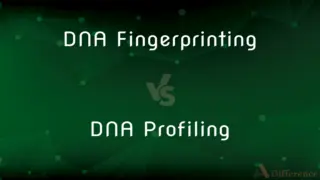Semiconservative Replication vs. Dispersive Replication — What's the Difference?
By Maham Liaqat & Fiza Rafique — Published on February 24, 2024
Semiconservative replication involves each new DNA molecule having one original strand and one new strand, whereas dispersive replication would result in DNA molecules with interspersed original and new segments.
Difference Between Semiconservative Replication and Dispersive Replication
Table of Contents
ADVERTISEMENT
Key Differences
Semiconservative replication, a fundamental concept in molecular biology, ensures genetic stability by preserving one of the original DNA strands in each new DNA molecule. This method underlines the precise duplication of genetic information during cell division. Dispersive replication, a theoretical model, suggested that DNA strands would be a patchwork of old and new segments after replication, which would complicate the faithful transmission of genetic information.
The semiconservative model was confirmed by the Meselson-Stahl experiment, which demonstrated that after one replication cycle in a medium with a different isotope of nitrogen, DNA molecules consisted of one old and one new strand. In contrast, dispersive replication would have resulted in a more uniform distribution of isotopes within DNA strands, which was not observed.
The efficiency and accuracy of semiconservative replication are crucial for maintaining genetic integrity across generations. It allows for the correction of errors through mechanisms like mismatch repair. Dispersive replication, had it been the mechanism in nature, would have posed significant challenges to error correction and genome stability.
Enzymes like DNA polymerase play a pivotal role in semiconservative replication, synthesizing new DNA strands complementary to the original templates. The hypothetical mechanism of dispersive replication would have required a different, more complex set of molecular machinery to splice and rejoin the old and new DNA segments.
Understanding the distinction between these replication models is essential for comprehending how genetic information is accurately passed down, with semiconservative replication being the foundation for genetic continuity and evolution.
ADVERTISEMENT
Comparison Chart
Mechanism
Each new DNA contains one original and one new strand.
New DNA contains interspersed segments of original and new DNA.
Experimental Evidence
Supported by the Meselson-Stahl experiment.
No experimental support; theoretical model.
Genetic Integrity
Maintains high fidelity in genetic information transfer.
Would potentially compromise genetic fidelity.
Error Correction
Facilitates accurate error correction mechanisms.
Would make error correction more complex and less efficient.
Biological Relevance
The universally accepted model for DNA replication.
A historical hypothesis, not observed in nature.
Compare with Definitions
Semiconservative Replication
Supported by the Meselson-Stahl experiment using nitrogen isotopes.
The experiment showed DNA strands of intermediate density after one replication cycle, confirming semiconservative replication.
Dispersive Replication
Was considered alongside conservative and semiconservative models.
Dispersive replication was one of the three initial hypotheses for DNA replication.
Semiconservative Replication
A DNA replication process where each daughter molecule contains one original and one new strand.
In human cells, semiconservative replication ensures each new cell receives an exact copy of DNA.
Dispersive Replication
Lacks concrete evidence in biological systems.
No known organisms exhibit dispersive replication for DNA.
Semiconservative Replication
Involves enzymes like DNA polymerase and helicase.
DNA polymerase synthesizes new strands in semiconservative replication.
Dispersive Replication
Served as a stepping stone in understanding DNA replication mechanisms.
The dispersive model contributed to the scientific discourse leading to the acceptance of semiconservative replication.
Semiconservative Replication
Ensures genetic stability and fidelity during cell division.
Semiconservative replication is crucial for preventing mutations in DNA.
Dispersive Replication
Would complicate the transmission of genetic information.
If dispersive replication occurred, genetic mutations might be more frequent.
Semiconservative Replication
Fundamental for understanding genetic inheritance and evolution.
Semiconservative replication is key to how traits are inherited.
Dispersive Replication
A theoretical model where DNA strands would be a mix of old and new segments.
Dispersive replication was proposed as an alternative to semiconservative replication but lacked experimental support.
Common Curiosities
What is the key feature of semiconservative replication?
The key feature is that each new DNA molecule consists of one original strand and one newly synthesized strand.
Can dispersive replication occur in any biological systems?
No, dispersive replication is a theoretical model and has not been observed in any known biological systems.
How does error correction work in semiconservative replication?
Enzymes can identify and correct mismatches, ensuring the new strand is an accurate copy of the original.
What would be the implications of dispersive replication for genetic diseases?
If dispersive replication were real, it could lead to higher mutation rates and potentially more genetic disorders.
Are there any organisms that do not follow semiconservative replication?
All known organisms follow semiconservative replication for DNA duplication.
What role do primers play in semiconservative replication?
Primers provide the starting point for DNA synthesis, allowing DNA polymerases to begin adding nucleotides.
How do replication forks function in semiconservative replication?
Replication forks are sites where the DNA double helix is unwound to allow template-directed synthesis of new strands.
Why was dispersive replication considered as a model?
It was considered due to limited initial understanding of DNA's molecular complexity and replication mechanisms.
Why is semiconservative replication important for genetic fidelity?
It ensures that each new cell receives an exact copy of the DNA, minimizing mutations and errors.
How was semiconservative replication experimentally confirmed?
The Meselson-Stahl experiment using nitrogen isotopes provided clear evidence supporting semiconservative replication.
How does semiconservative replication contribute to evolution?
It allows for the stable inheritance of genetic material, with mutations occurring at a manageable rate, driving evolution.
Why is dispersive replication considered less efficient than semiconservative replication?
It would require more complex mechanisms to splice together old and new DNA segments, potentially reducing replication fidelity.
How has our understanding of semiconservative replication impacted genetics?
It has laid the foundation for molecular genetics, biotechnology, and our understanding of hereditary diseases and their treatments.
How does semiconservative replication affect medical research?
Understanding this process is crucial for developing treatments that target cell division, such as cancer therapies.
Is there any scenario where dispersive replication could be beneficial?
Theoretically, dispersive replication might offer a faster replication process but at the cost of accuracy and genetic stability.
Share Your Discovery

Previous Comparison
Eau de Parfum vs. Eau de Toilette
Next Comparison
DNA Fingerprinting vs. DNA ProfilingAuthor Spotlight
Written by
Maham LiaqatCo-written by
Fiza RafiqueFiza Rafique is a skilled content writer at AskDifference.com, where she meticulously refines and enhances written pieces. Drawing from her vast editorial expertise, Fiza ensures clarity, accuracy, and precision in every article. Passionate about language, she continually seeks to elevate the quality of content for readers worldwide.













































